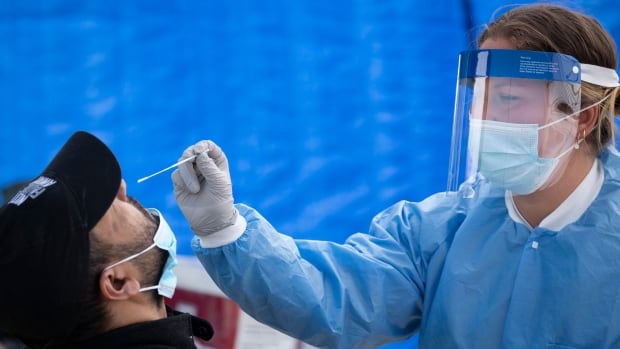

A resurgence in coronavirus infections in several provinces over the last few weeks has raised alarms about current disease control measures in place and what steps need to be taken to curb the spread of the virus.
B.C, Alberta, Manitoba, Ontario and Quebec have all reported a bump in cases throughout September, and some have paused their reopening plans as a result.
Those under 40 are driving the spread in most provinces. In Ontario, health officials have identified smaller, indoor gatherings as the culprit. Younger people may also be working in precarious jobs where their exposure is increased, or where sick days may not be readily available.
Officials will need to determine which reopening policies to roll back and which to keep, as cases mount. Those choices will need to be made quickly, infectious disease experts told CBC News.
“In pandemics, it’s all about the speed of response,” said Dr. Matthew Oughton, an infectious disease specialist at Jewish General Hospital and assistant professor at McGill University in Montreal.
“The slower you are for something that spreads and expands exponentially, the farther and farther behind you’re going to get.”
CBC News spoke to experts in three provinces that are seeing stark increases in caseloads — Alberta, Ontario and Quebec — about what needs to be done immediately in order to keep COVID-19 case numbers as low as possible.
‘Difficult decisions’ on keeping businesses open
Alberta is starting to see a similar case load to Ontario and Quebec, which is concerning as the prairie province has a much lower population, said Dr. Stephanie Smith, an infectious disease expert at the University of Alberta in Edmonton.
For the first 15 days of September in Alberta, the province has reported an average of 137 new cases of COVID-19 per day. That’s up from an average of 88 cases for that same period in August, meaning that cases have gone up by about 55 per cent in the last month.
The province is also facing widespread community transmission of COVID-19, rather than the disease appearing in a few specific hotspots, like a long-term care facility, said Smith.
While some of the increase in Alberta cases could be attributed to more testing in September, with upwards of 30,000 people tested per day, these jumps in case counts are still concerning, said Smith.
WATCH| How will a ‘second wave’ of coronavirus cases need to be handled?:
“If there’s ongoing, rising cases, I think public health will have to make the difficult decisions to look at whether we should be closing certain types of businesses,” she said.
“It makes it more challenging for public health, because there’s a huge reluctance to go backwards … when it’s so detrimental to the economy.”
Targeted information about public health measures needs to be given to young people and those who face health inequities in urban centres, said Smith.
“Each individual public health unit needs to determine where they are seeing cases and determine the best steps in terms in trying to mitigate those rising numbers,” she said. “It does very much depend on the particular demographics.”
Large indoor gatherings need to be halted in Ontario: professor
As Ontario continues to report a surge in coronavirus cases, the province plans to reimpose public health restrictions on residents.
Ontario has seen an average of 184 cases a day for the first 15 days of September, compared to 90 cases a day for the same period in August. This amounts to a 104 per cent increase in reported infections, month over month.
On Wednesday, the Ford government announced that limits on social gatherings would be implemented in some regions. Ontario has taken a staged approach to the pandemic since March and allowed for variation in the reopening plan depending on the case load in a particular region.
WATCH| Ontario looks to the private sector to handle long line-ups at testing centres:
The source of the uptick in COVID-19 cases is being driven by younger people in Ontario, just as some are beginning to return to university campuses, said Gerald Evans, an epidemiologist at Queen’s University in Kingston, Ont.
And a rise in infections within that age demographic is consistent with what’s been reported in other countries, such as Austria, France and Spain, he said.
While younger people tend to have less serious infections, there’s no guarantee the virus won’t spread to more vulnerable groups.
“We know from heat maps from lots of countries where you look at the continued rising numbers in that age demographic, is that it emerges into the general community … and into the elderly,” he said, adding that it will also impact children and staff in schools.
The Ontario government also needs to look into curtailing some businesses that opened in Stage 3, such as limiting bar hours and pausing events like indoors weddings, said Evans.
Harder hit neighbourhoods need increased support
Neighbourhoods bearing the brunt of COVID-19 in urban centres like Toronto need more targeted supports as cases rise, said Arjumand Siddiqi, an associate professor at Dalla Lana School of Public Health and the Canada Research Chair in population health equity.
WATCH| Neighbourhoods at higher risk for COVID-19 in Toronto require more supports:
These neighbourhoods, where more people of colour live, are facing long-standing health inequities that have been exacerbated by the pandemic, said Siddiqi.
Eighty-three percent of Toronto’s COVID-19 cases are Black people and other people of colour, according to July data from the City of Toronto.
A real investment in these neighbourhoods by governments is required to keep people safe, she said.
“COVID is the umpteenth health outcome to show a disparity because we never get to that conversation about what we fundamentally need to do to fix the fact that health care is unequally distributed.”
In the short term, that investment could look like more isolation centres for those in high-density housing that don’t have room to distance, as well as better access and transportation to testing facilities, she said.
As well, many people of colour who live in these areas are in low-paying jobs that put them at greater risk of COVID-19, said Siddiqi.
“A lot of low wage jobs don’t have sick leave. So providing that, and encouraging the kind of policies that would make sure that people can actually use their sick leave.”
Policing private, indoor gatherings a challenge in Quebec
Dr. Matthew Oughton says cases in Quebec are “picking up speed” in terms of community spread and that the majority of cases are happening with a younger population.
The average number of cases Quebec has reported in the first 15 days of September has been around 204 per day, compared to 90 per day the province recorded for the same period in August.
“The major contributor seems to be not one huge outbreak … but seems to be much more community transmission based on small family and friend gatherings,” said Oughton.
WATCH| Cases climb in Quebec despite months of restrictions:
If cases continue to climb in Quebec, “there’s a real risk” schools will need to be shuttered, Premier François Legault said at a press conference Wednesday.
“It’s very complex to see how we can enforce the maximum of 10 [people in private gatherings] or social distancing in every house in Quebec,” Legault told reporters.
While Oughton says he sympathizes with the challenges the government is facing — he says the province has been “aggressive” with their reopening plan in recent months and it was likely too much, too fast.
“The Quebec government was very aggressive at getting children back to school. Their list of medical exemptions that would allow a child to stay home and do distance learning was very, very restrictive,” he said.
On Tuesday, Quebec reported at least 377 cases of COVID-19 across 223 schools.
“We don’t have a well-established broad-scale program for distance learning and it looks more and more if this trend continues that we’re going to need that,” said Oughton.
Businesses like bars may be hard to keep open as infections rise if keeping schools open remains a priority, he said.
“That’s no where near sufficient. [COVID-19] spreads exponentially, and we need to be ahead of this, not constantly playing catch-up,” he said.












